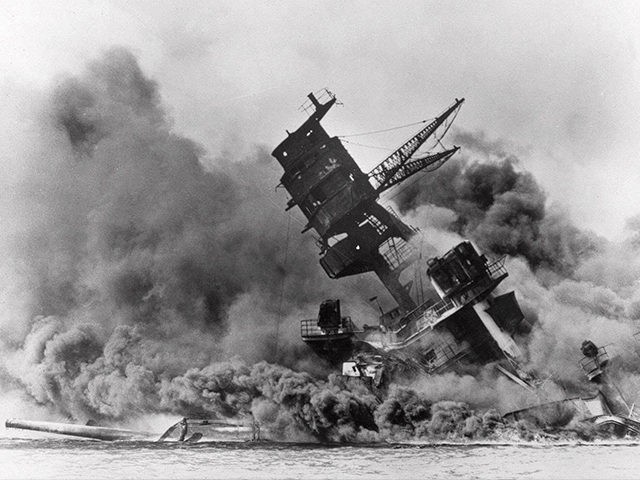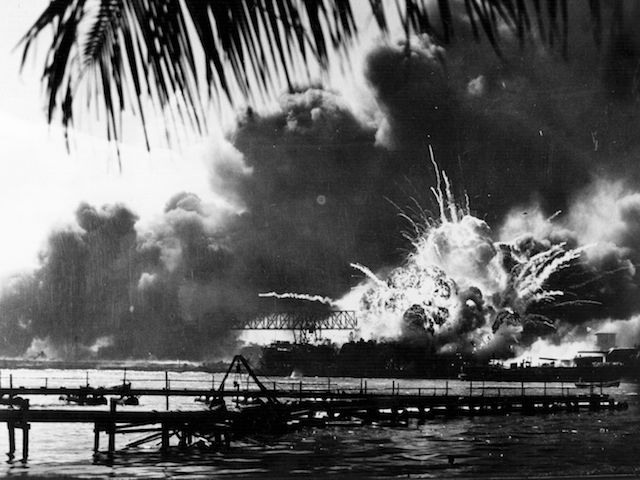The Attack That ‘Enraged America:’ Victor David Hanson Explains Japan’s Miscalculation at Pearl Harbor
 Associated Press
Associated PressRenowned historian Victor Davis Hanson explained in a recent PragerU video the events of December 7, 1941, and what the Japanese were thinking when they attacked Pearl Harbor without warning. “The Japanese underestimated American strength and overestimated their own,” Hanson said. “Instead of cowing America, the Pearl Harbor attack enraged it.”
“It was one of the most successful and failed surprise attacks in military history,” Hanson said. “The bombers sank four battleships of the U.S. 7th fleet, damaged four others, and killed over 2,300 American sailors and soldiers.”

A small boat rescues sailors from the USS ‘West Virginia’ after she had suffered a hit in the Japanese attack on Pearl Harbor. The USS Tennessee (BB-43) is inboard of the sunken battleship. (Photo by Fox Photos/Getty Images)
Hanson went on to explain that while “the attack was brilliant,” it “did not achieve its goal,” because, “by a twist of fate, the three American aircraft carriers based at Pearl, the ships the Japanese most wanted to destroy — Enterprise, Lexington, and Saratoga — were all out to sea on the 7th, and safe.”
Moreover, “the Japanese didn’t finish the job,” Hanson continued, explaining that the Japanese needed “three attack waves,” rather than just two, in order to destroy “a full six months worth of stored naval and aviation fuel, dockyards, and maintenance shops, and truly set the Americans reeling.”
Watch Below:
Hanson said that Japan attacked Pearl Harbor because it believed “it had to neutralize America” in order “to dominate and control all of Asia, its people, and its resources.”
“From the hindsight of history, this appears suicidal, but at the time, it almost made sense,” he said, adding that “in 1940, the United States was, militarily speaking, in a sorry state.”
“The ships in its pacific fleet were few, and many were outdated,” Hanson explained. “The Japanese fleet, in contrast, was newer, bigger, and stronger. Second, America had no appetite for overseas conflict.”

The American destroyer USS Shaw explodes during the Japanese attack on Pearl Harbour (Pearl Harbor), home of the American Pacific Fleet during World War II. (Photo by Keystone/Getty Images)
“Like the rest of the world, the Japanese had watched most of Europe fall to the Nazis while America did little to stop it,” he added. “If the U.S. wasn’t going to fight in Europe, where it had many alliances, why would it fight in Asia where it had few?”
“The Japanese reasoned America would sue for peace,” Hanson said of Japan’s thought process when it attacked Pearl Harbor.
But “just as Hitler underestimated Soviet strength and overestimated their own, the Japanese underestimated American strength and overestimated their own. Instead of cowing America, the Pearl Harbor attack enraged it,” Hanson said.
Hanson explained what then followed the Pearl Harbor attack:
Within six months, General Jimmy Doolittle led a surprise bombing raid on Tokyo, an astounding feat no one at the time, including the Japanese, considered possible.
By August 1942, a mere nine months after Pearl Harbor, American forces shifted to offense, landing marines on the island of Guadalcanal. Meanwhile, at home, the nation was gearing up for the greatest industrial renaissance in the history of civilization.
In a little more than three years, the United States would build more war ships and support vessels than all the navies in the world combined.
“In the hindsight of history, it seems like the allied victory was inevitable,” Hanson said. “But victory came at a terrible price. Over 110,000 American servicemen died, and over 250,000 were wounded to win the war in the Pacific, and another 21,000 spent time in horrific Japanese prisoner of war camps.”
“Preparing for war is expensive, but not nearly as expensive in blood and treasure as fighting a war,” the renowned historian concluded. “That’s one of the many lessons to be learned from what happened on the fateful day of December 7, 1941.”
You can follow Alana Mastrangelo on Facebook and Twitter at @ARmastrangelo, and on Instagram.
